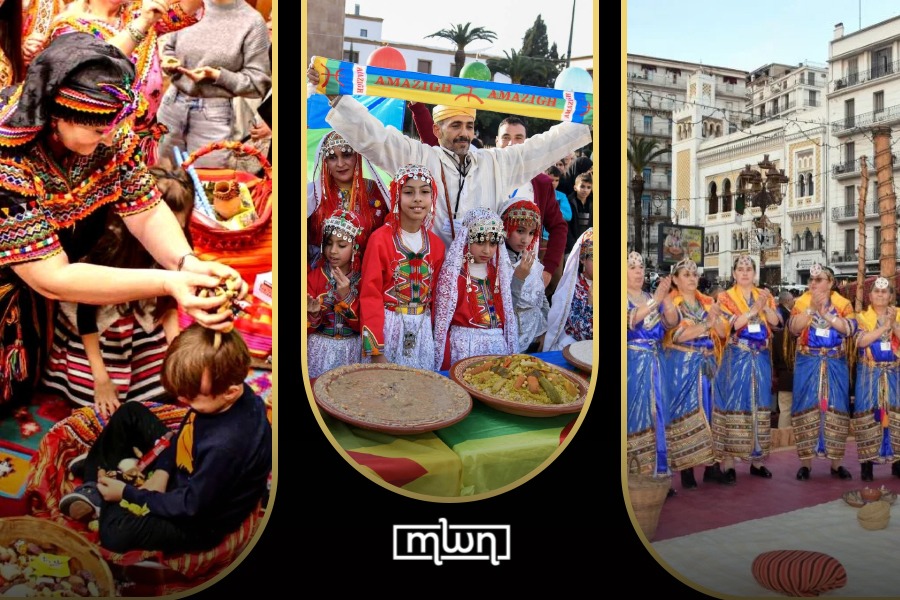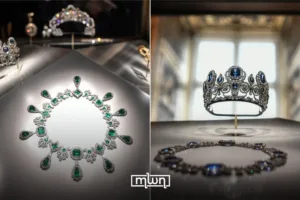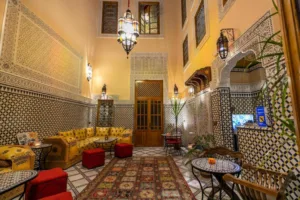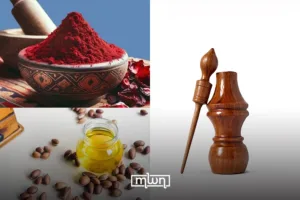As we celebrate Yennayer 2975, let’s honor the Amazigh people’s rich cultural heritage by delving into the timeless beauty of their traditional attire.
Fez – Amazigh attire is as diverse as the regions it represents, with vibrant colors, intricate designs, and layers of meaning.
From the majestic Atlas Mountains to southern Morocco, these garments reflect a deep connection to heritage. Yet, this traditional dress isn’t confined to Amazigh regions alone—it has found admirers far beyond, thanks to designers who have reimagined it for modern audiences.
One of the most iconic pieces is the Amazigh long and layered skirt, a symbol of modesty and elegance, called colloquially a “Saia”. Certain regions have unique variations of the skirt, like the “Semlalia” saia from the Idda Oussmlal area in Tafraoute, which is distinguished by its vibrant colors and intricate patterns.
Paired with the equally dazzling Amazigh caftan — usually red with colorful pom-poms — these garments form an enchanting ensemble.
In the Soussi regions, for everyday wear, women also wear this shirt alongside white “Adals” — the long Amazigh head scarves that serve the dual purpose of keeping modest and cool during the warmer months.
Women in Tafraoute are also known to wear the black “melhfa” — a long black garment that elegantly wraps around the body from head to toe.
No Amazigh outfit is complete without its distinctive silver jewelry, often adorned with colorful gemstones. These pieces are more than decorative—they carry stories and, at times, have played a role in historical resistance.
The “Tessqwin“, a horn-shaped headpiece, is both a crown and a cultural emblem. During the French colonial era, women in southern Morocco ingeniously used these accessories to conceal and transport gunpowder and ammunition to resistance fighters.
Loose-fitting dresses allowed them to smuggle small weapons undetected, turning their attire into tools of defiance and survival.
The “Khellala”, a triangular brooch, and the “Mezboud”, a silver tiara, are other cherished adornments. Women also wore heavy bracelets called “Tazarzit,” designed with sharp edges for protection—a literal shield in times of danger.
Traditional jewelry collections also have the “Tasdidt,” a silver necklace adorned with old coins, and the “Tawnza,” a silver crown, all made with intricate detail by Amazigh artisans.
Every detail of Amazigh attire serves a purpose beyond beauty. The “Istrah,” a handwoven belt often in red, black, or brown, is a marvel of both form and function.
Women use it for support during strenuous tasks like carrying wood, drawing water, or harvesting crops.
This belt, often up to five meters long, is essential for the backbreaking labor Amazigh women have historically undertaken.
Another key element is the “Tasbint,” a vibrant, embroidered headscarf, paired with the “Taassabt,” a second layer that secures it in place.
Together, they ensure modesty while adding a burst of color to the ensemble.
Amazigh clothing isn’t just about daily wear; it carries profound ceremonial importance. The “Tamizart,” a shawl made from wool and silk, is a treasured gift from mothers to their daughters, passed down through generations.
Even the footwear, like the “Tirchasine,” a leather shoe embroidered with colorful threads, adds to the outfit’s harmony. As Amazigh women don their traditional attire, they embody a legacy of resistance, beauty, and cultural pride.
From the vibrant fabrics to the ingenious use of accessories, these garments worn by these powerful women stand as a testament to the enduring spirit of the Amazigh people.
As we celebrate the Amazigh New Year — Yennayer 2975 — on Tuesday, let’s honor their contributions to Morocco’s rich tapestry of cultures.
Read also: Preserving Morocco’s Fading Traditions in Today’s Modern Age
















